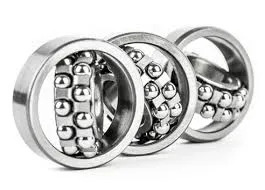
Nov . 10, 2024 17:33 Back to list
Understanding Double Angular Contact Bearings and Their Applications in Machinery
Understanding Double Angular Contact Bearings
Double angular contact bearings are crucial components in various machinery and automotive applications. Distinct from standard bearings, these bearings are designed to accommodate axial loads in both directions while also handling radial loads. This unique capability makes them ideal for applications that demand high precision and durability.
Design and Structure
Double angular contact bearings consist of two rows of rolling elements—typically balls—arranged between the inner and outer rings. The key distinguishing feature is the angle at which the balls are positioned with respect to the axis of the bearing. This angle allows the bearing to handle axial loads effectively in both directions, unlike single row angular contact bearings, which can only manage axial loads in one direction.
The races in double angular contact bearings are usually angled at an innovative design that enhances contact between the balls and the races. This design minimizes stress and wear on the bearing surfaces, contributing to a prolonged lifespan. The arrangement of the two rows of rolling elements in a tight formation maximizes load capacity, making these bearings particularly advantageous in high-load applications.
Applications
Double angular contact bearings are used in a variety of industries and applications. One prevalent use is in the automotive sector, where they are employed in wheel hubs, steering systems, and gearboxes. The ability of these bearings to support high axial and radial loads makes them ideal for automotive applications where precision and reliability are crucial.
double angular contact bearing

In the aerospace industry, double angular contact bearings are utilized in various critical systems, including control surfaces and landing gear
. These bearings are synonymous with high performance, as they must withstand extreme conditions while ensuring smooth operation and flight safety.Another significant application is found in high-speed machine tools and spindles used in manufacturing. The need for precision machining requires bearings that can handle both radial and axial loads, maintaining accuracy even under high-speed conditions. Double angular contact bearings fulfill this requirement effectively.
Advantages
The advantages of double angular contact bearings extend beyond load capacity and precision. Their design allows for a smaller footprint while providing superior performance compared to other bearing types. This characteristic is especially beneficial for manufacturers seeking to optimize space without compromising on quality.
Furthermore, the robustness of double angular contact bearings enhances reliability. They are less prone to failures and can operate efficiently in a wide range of temperatures and conditions. Their long operational life translates to reduced maintenance costs, making them a cost-effective choice in the long run.
Conclusion
Double angular contact bearings are essential components that facilitate efficient operation in various applications, from automotive to aerospace and manufacturing. Their unique design accommodates complex loading conditions, ensuring that machinery runs smoothly and reliably. As industries continue to evolve, the demand for high-performance bearings like double angular contact bearings will undoubtedly grow, underscoring their importance in modern engineering and manufacturing processes. Whether for high-speed applications or heavy loads, these bearings serve as a testament to engineering innovation, enhancing both performance and dependability in a wide range of applications.
Latest news
-
Premium Deep Groove Ball Bearings | High Speed & Reliability
NewsAug.29,2025
-
Durable Scaffolding Clamps - Secure & Reliable Tube Connectors
NewsAug.28,2025
-
Common Failures in Thrust Ball Bearings and Solutions
NewsAug.22,2025
-
How Tapered Roller Bearings Can Take Shock Loads
NewsAug.22,2025
-
Angular Bearings in High-Precision Spindles
NewsAug.22,2025
-
The Impact of Misalignment on Cylindrical Roller Bearing Performance
NewsAug.22,2025
